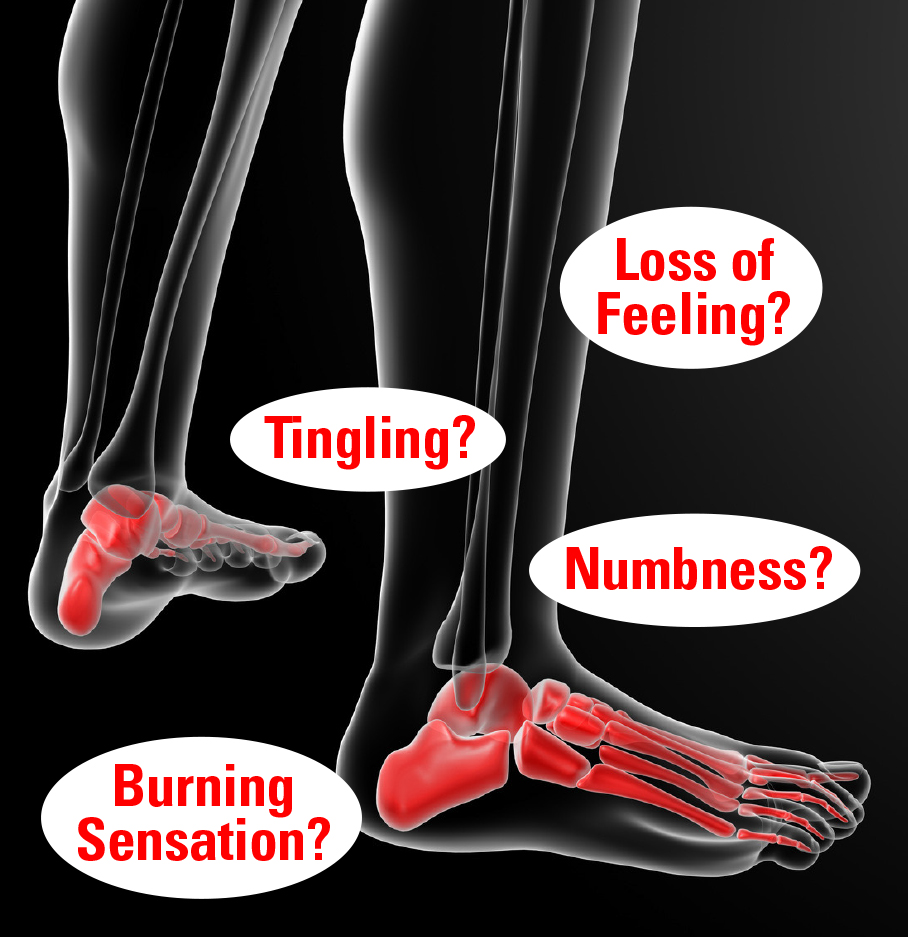NEUROPATHY—NERVE NUMBNESS
If you have a patient dealing with the “pins and needles” or burning sensation in their feet, legs, and arms from diabetic neuropathy, here’s good news. They don’t have to rely on prescription drugs for relief. There’s a better way and here’s more about it.
INFOMEDICA’S BOTTOM LINE:
While there are prescription drugs available to treat diabetic neuropathy, they don’t repair delicate blood vessels and nerve endings and help the body repair some of the pathways that are involved in metabolizing blood sugar. Plus, they have significant side effects.
Fortunately, there are safe and effective nutrients that can make a big difference. Together, they will:
- Stop tingling and numbness
- Reduce pain in feet, legs, fingers, and hands
- Repair damaged nerves and blood vessels
- Prevent damage to nerve endings
- Help metabolize carbohydrates and sugars

If you have a patient dealing with the feeling of “pins and needles,” a burning sensation in their feet, legs, and arms, intense stabbing pain and struggle with blood sugar, they may have peripheral neuropathy. And they’re not alone.
According to the National Institute of Diabetes and Digestive and Kidney Disease:
• About 60 to 70 percent of diabetes patients have neuropathy.
• Symptoms may not appear until about 10 to 20 years after the diagnosis of diabetes.
• Sedentary lifestyles, poor diets, and insulin resistance may mean that many people aren’t aware they have diabetes until they have symptoms.
Prescription drugs typically recommended for diabetic neuropathy vary, but all cause their share of significant side effects. They range from antidepressants and anti-seizure medications to pain relievers and anti-nausea medicines. But none of them really get at the core of the problem – repairing delicate blood vessels and nerve endings and helping the body repair some of the pathways that are involved in metabolizing blood sugar. Fortunately, along with lifestyle choices, specific nutrients can stop – and even reverse – the symptoms and causes of neuropathy.
For example, patients with high rates of blood sugar have been found to be deficient in vitamin B6. Those who were given pyridoxal-5-phosphate (P-5-P), the active form of vitamin B6, showed reduced blood glucose levels after only 7 days.
Active B Vitamins: Readily Used by the Body
Most forms of B vitamins need to be converted by the liver into a form that is readily used by the body.
However, vitamin B6 as pyridoxal-5-phosphate (P-5-P), vitamin B12 as methylcobalamin, and folate as L-methylfolate are already in the form the body uses. Together, they protect nerve endings and reduce levels of inflammatory homocysteine that damage blood vessels.
Other B vitamins are important for blood sugar metabolism and nerve health as well. For example, people with diabetes are typically deficient in thiamin, or vitamin B1, much like vitamin B6. Thiamin helps the body metabolize carbohydrates effectively and to turn those calories into energy. Without it, not only do sugars not break down as they should, (leaving more in the bloodstream), but chances of oxidative damage and inflammation in the blood vessels increase.
Benfotiamine is a fat-soluble form of vitamin B1 (thiamin) that can achieve five times the concentration in the body compared to standard water-based thiamin. Benfotiamine prevents glucose toxicity and brings elevated blood sugar levels back down to normal. Benfotiamine has also been clinically proven to reduce pain and complications of diabetic neuropathy, the “pins-and-needles” and “tingling” that people with diabetes feel in their feet and legs. The active form of vitamin B12, methylcobalamin, is another “must-have” for those with diabetic neuropathy. Vitamin B12 supports the nerve structures that move signals throughout the body – some of the very structures that are threatened by inflammation and damage from elevated blood sugar levels. The sooner this nutrient is a part of a regimen, the better. According to the Annual Review of Nutrition, up to 15 percent of individuals over 60 are B12 deficient.
Like vitamin B12, folate can be administered in forms that are easier for the body to absorb, and L-methylfolate is one of them. Research published in the journal Reviews in Neurological Diseases found that L-methylfolate, methylcobalamin, and P-5-P improved the epidermal nerve fiber density (ENFD) in 73 percent of the treated patients with type 2 diabetes in just six months. Additionally, 82 percent reported reduced frequency and intensity of the “pins and needles” feeling or of the painful sensation (or lack of sensation) brought about by simple touch and contact.
Riboflavin, also known as vitamin B2, was one of a group of nutrients, including thiamin, folic acid, and vitamin B6 and B12 that reduced diabetic neuropathy symptoms in a randomized, double-blind, placebo-controlled study over the course of four months.
Of course, the same damage that occurs to nerves and blood vessels in our legs can happen in the delicate structures of the eye as well. Riboflavin helps keep reduced glutathione – the body’s natural free-radical fighter – active in the eyes. In fact, there’s a correlation between riboflavin deficiency and the development of cataracts. In clinical research, the greatest reduction in cataract risk was seen in those taking a combination of riboflavin and niacin.
Pantothenic acid is another member of the B vitamin family sometimes referred to as “vitamin B5.” As seen with deficiencies of other B vitamins, a lack of pantothenic acid can cause numbness and tingling in the feet. The nutrient’s primary role in the body is as Coenzyme A. As a coenzyme, it is involved in many important functions, one of which is healthy tissue formation (including that of nerve endings and blood vessels). But high blood sugar levels can affect levels of Coenzyme A, so it’s a good idea to include pantothenic acid along with these other B vitamins.
Alpha-lipoic acid can boost levels of glutathione, helping save delicate nerves from oxidative damage. It fights diabetic neuropathy by normalizing the intake of blood sugar by the muscles, in addition to reducing the pain and tingling of peripheral nerves. The best results come from a 600 mg per day dose of alpha-lipoic acid.
Chromium is an essential trace mineral that helps prevent the build-up of glucose in the bloodstream. If a person has just been diagnosed with type 2 diabetes, or have elevated blood sugar levels, getting chromium into their regimen is important. In a clinical study, individuals taking chromium reduced their fasting blood glucose level from an average of 197 to 103 in just three months.
Zinc promotes tissue and wound healing. It also stabilizes pancreatic storage of insulin and inhibits oxidative stress that promotes insulin resistance and diabetes. Reduced zinc levels in the pancreas are associated with diabetes, and proper amounts of this mineral tend to keep insulin levels at an even keel.
While there are many forms of minerals available as supplements, amino acid chelated forms are easily used by the body. The bonding of a mineral to the amino acid glycine creates a mineral form that passes through the intestinal wall and is incorporated into the bloodstream much more efficiently.
Boswellia (Boswellia serrata) is one of nature’s most powerful anti-inflammatory medicines. It is a specific inhibitor of 5-LOX, an enzyme that activates inflammation-inducing leukotrienes. One of the biggest difficulties for people with nerve damage from diabetes is the pain and inflammation that goes along with it.
The most active and beneficial of the boswellic acids in the extract is known as AKBA (Acetyl-11-keto-B-boswellic acid). However, not all boswellia extracts are equally beneficial. For example, in unstandardized boswellia products, the AKBA levels can be very low – sometimes as little as 1 percent. To make sure you recommend the best, look for boswellia standardized to at least 10 percent AKBA.

A combination of nutrients is best for treating diabetic neuropathy. Recommend B vitamins [thiamin and benfotiamine, riboflavin, niacin, vitamin B6 (P-5-P), folate, vitamin B12 (methylcobalamin), biotin, and pantothenic acid], along with the chelated minerals zinc and chromium, and alpha-lipoic acid and boswellia.


